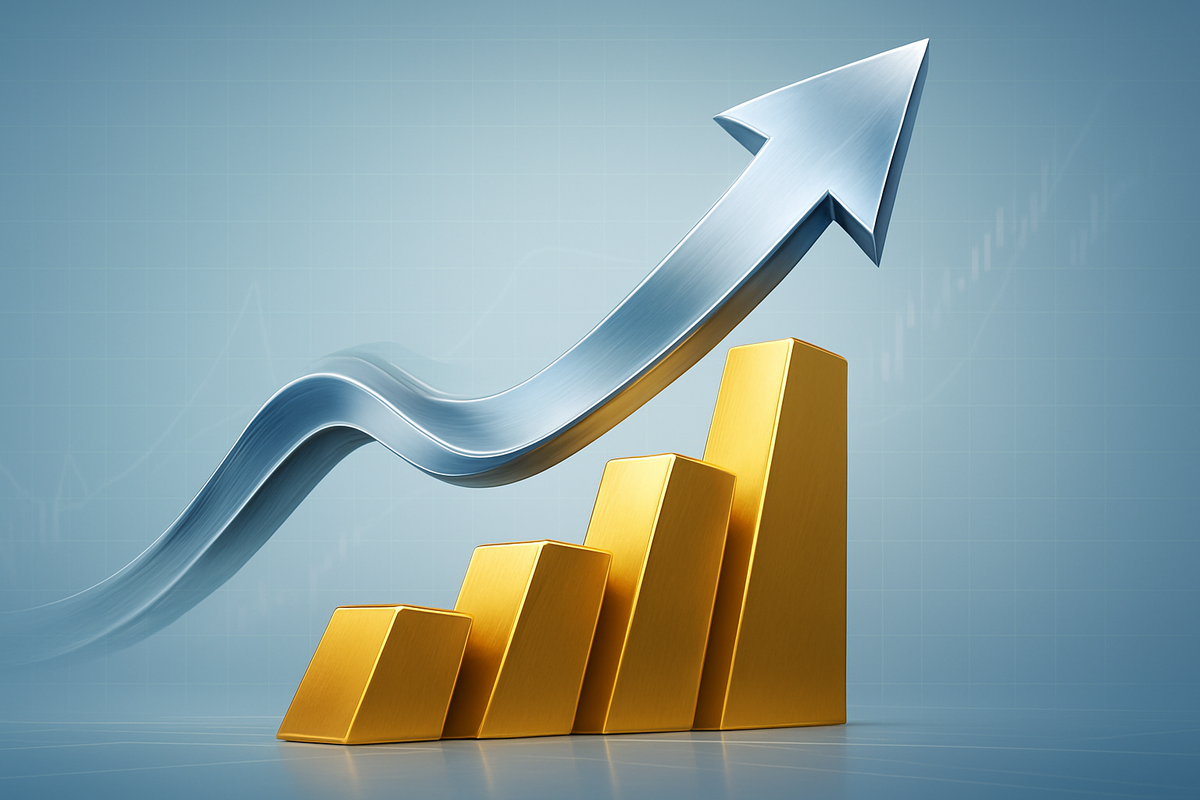
The precious metals market is currently witnessing a remarkable and compelling shift, with silver aggressively asserting its dominance over its more traditionally revered counterpart, gold. As of late 2025, the iShares Silver Trust (NYSE: SLV) has not only demonstrated robust performance but has become a beacon for investors seeking substantial gains, reflecting a broader trend where silver is increasingly outperforming gold. This dynamic reversal in fortunes underscores a pivotal moment in the commodities landscape, signaling a potential recalibration of investment strategies and a renewed appreciation for the industrial and monetary value of the white metal.
This significant divergence in performance has profound implications for global financial markets, challenging long-held assumptions about precious metal investments. Silver's ascent, marked by impressive price surges and sustained momentum, suggests a complex interplay of macroeconomic factors, burgeoning industrial demand, and shifting investor sentiment. The spotlight is now firmly on silver, prompting a deeper examination of the forces propelling its extraordinary rally and what this means for the future of both metals in a volatile global economy.
Silver's Meteoric Rise and Gold's Steady Climb
The period leading up to November 28, 2025, has been nothing short of transformative for precious metals, with silver emerging as a standout performer. Gold, while maintaining its status as a safe-haven asset, has seen its impressive gains overshadowed by silver's more explosive trajectory. In 2024, gold delivered a strong 26.3% return, reaching numerous all-time highs driven by anticipation of monetary easing, aggressive central bank purchases, persistent geopolitical tensions, and rising U.S. government debt. This bullish momentum continued into 2025, with gold surpassing the $4,000 per ounce threshold in Q3 2025 and showing a remarkable decoupling from traditional economic indicators.
However, silver's story is one of even more dramatic appreciation. After a strong bullish run in 2024 with an annual gain exceeding 20% and reaching a yearly high of $34.85, the metal truly ignited in 2025. Prices surged from approximately $28.9 at the start of the year to an astonishing all-time high of $54.46 on October 17, 2025, effectively more than doubling its price within a year. This exceptional rally has been fueled by a confluence of factors, including anticipated US Federal Reserve interest rate cuts, pervasive global economic uncertainty driving safe-haven buying, and critically, near-record industrial demand.
The iShares Silver Trust (NYSE: SLV), a key vehicle for investors to gain exposure to silver, has mirrored this spectacular performance. SLV jumped over 33% in 2024, outperforming the SPDR Gold Trust ETF (NYSEARCA: GLD). Its robust ascent continued into 2025, with a year-to-date return of 68.7% as of October 2025. By November 28, 2025, SLV was trading around $48.95, having seen its value increase by a staggering 73.35% over the past 12 months, with a 52-week range spanning from a low of $26.19 to a high of $51.17. The fund's Assets Under Management (AUM) reached $23.90 billion, underscoring significant investor confidence and capital inflow.
A crucial indicator of silver's relative strength is the gold-silver ratio, which measures how many ounces of silver are needed to buy one ounce of gold. Historically, this ratio has hovered between 50:1 and 60:1. While still above historical norms, standing around 80:1 to 83:1 as of November 2025 (with gold near $4,000/oz and silver between $48-$49/oz), the significant decline from its March 2020 peak of 125:1 highlights silver's substantial gains. This narrowing gap, particularly with the ratio in the 80:1 to 86:1 range, has historically often preceded periods where silver continues to outperform gold, suggesting further upside potential for the white metal.
Companies Poised to Win and Those Facing Headwinds
The extraordinary surge in silver prices has created a distinct cleavage in the corporate landscape, delineating clear winners and potential losers. Companies primarily engaged in silver extraction, refining, and financing are experiencing a significant boon, while industrial users of the metal face escalating input costs. A notable shift in investor preference from gold to silver could also introduce headwinds for purely gold-focused entities.
Leading the charge among beneficiaries are primary silver mining companies. These firms, whose revenue is directly tied to silver production, are seeing amplified profit margins and improved financial health. Prominent players include Pan American Silver Corp. (NASDAQ: PAAS), which has strategically expanded its silver reserve base, and First Majestic Silver Corp. (NYSE: AG), known for its focus on silver production in Mexico. Other notable beneficiaries are Hecla Mining Company (NYSE: HL), a major U.S. silver producer, and Aya Gold & Silver (TSX: AYA), recognized for its high-grade deposits and cost advantages. Companies like MAG Silver (NYSE: MAG), with its significant interest in the world-class Juanicipio project, are also positioned for substantial gains. The operational leverage inherent in mining means that every dollar increase in silver price can translate into disproportionately higher profits.
Royalty and streaming companies, which provide upfront capital to miners in exchange for a percentage of future production or revenue, are also thriving in this environment. These entities benefit from rising commodity prices without incurring the direct operational risks of mining. Wheaton Precious Metals Corp. (NYSE: WPM), a dominant force in both gold and silver streaming, and Franco-Nevada Corporation (NYSE: FNV), the largest and most diversified precious metals royalty company, are excellent examples. Their business model allows them to convert nearly all additional revenue from higher silver prices directly into profit, making them highly attractive to investors seeking leveraged exposure. Furthermore, silver refining companies, such as Hindustan Zinc, Umicore, and Asahi Refining, are witnessing increased activity and growth due to the heightened demand for processed silver in both investment and industrial applications.
Conversely, industries heavily reliant on silver as a raw material are grappling with increased production costs. Electronics manufacturers, who utilize silver for its superior electrical conductivity in everything from smartphones to electric vehicles, are facing higher input expenses. Solar panel manufacturers, including companies like First Solar, Inc. (NASDAQ: FSLR), are particularly vulnerable as silver is a critical component in photovoltaic cells. Similarly, jewelry manufacturers and certain medical equipment producers are experiencing elevated material costs, which could impact their profitability or necessitate price increases for consumers. While some may explore alternative materials, silver's unique properties often make substitution challenging. Moreover, while gold has also performed strongly, a sustained shift in investor preference towards silver could lead to comparative underperformance for purely gold-focused miners like Newmont Corporation (NYSE: NEM) and Barrick Gold Corporation (NYSE: GOLD), potentially diverting capital flows and tempering their relative upside.
The Wider Significance: A Dual-Natured Metal Reshaping Industries
Silver's exceptional outperformance is not merely a fleeting market anomaly; it represents a profound shift with wider significance across multiple industries and the global economic landscape. Its dual identity as both a precious metal and a critical industrial commodity is at the heart of this transformation. While gold's demand largely stems from its role as a store of value and jewelry, over half of silver's annual consumption is rooted in vital industrial applications, a factor increasingly driving its price. The confluence of a weakening U.S. dollar, volatile bond markets, global central bank interest rate cuts, and a structural supply deficit since 2021 has only amplified silver's appeal.
The ripple effects of silver's surge are most evident in high-growth industrial sectors. The solar energy (photovoltaics - PV) industry, for instance, is the most dynamic driver of silver demand, consuming a substantial portion of global supply. As the world pushes for renewable energy, silver's role in solar cells is indispensable. However, the rapidly increasing price of silver, now constituting about 14% of solar module production costs (up from 5% in 2023), is compelling manufacturers to accelerate research into silver-reduction technologies and alternative materials like copper metallization and graphene. Similarly, the electronics and electrical sector, silver's largest industrial application, and the burgeoning electric vehicle (EV) industry are experiencing increased demand for silver in components, batteries, and wiring. Innovations like Samsung's new solid-state battery technology, which uses a silver-carbon composite, could dramatically increase silver demand per EV, further solidifying its critical role.
This heightened demand and price volatility have significant implications for competitors and partners. For manufacturers, the rising cost of silver intensifies the search for substitutes, though replacing silver's superior properties in many applications remains challenging. For miners, higher silver prices incentivize increased exploration and production, although the fact that about 72% of silver is a byproduct of other metal mining means its supply response to price changes can be somewhat inelastic. Fabricators face margin pressures, pushing them towards innovation in silver-lean technologies. Investors, recognizing silver's lower price point, higher volatility, and strong industrial demand, are increasingly diversifying their portfolios into the metal, viewing it as offering greater upside potential than gold, particularly in a market where central bank policies are making non-yielding assets more attractive.
From a regulatory and policy perspective, the U.S. government's designation of silver as a critical mineral in 2025 is a landmark development. This status could trigger new policies aimed at securing supply chains, promoting domestic production, and encouraging silver recycling, underscoring its strategic importance. Furthermore, global commitments to green economy policies, such as China's energy transition initiatives and the U.S. Inflation Reduction Act (IRA), are foundational drivers for silver demand in solar panels and EVs. Historically, silver has often outperformed gold during bull markets in precious metals, largely due to its smaller market size, which contributes to greater price volatility and more significant percentage gains during upward swings. The current decline in the gold-to-silver ratio, from its pandemic peak of 125.1:1 to around 78:1 in October 2025, mirrors historical periods like the 1970s and early 2000s, where silver delivered dramatic outperformance, suggesting that the current market cycle is following a well-established pattern of silver leading the charge in the later stages of a precious metals rally.
What Comes Next: Navigating a Shifting Precious Metals Landscape
The future trajectory of silver and gold, extending into 2026 and beyond, is poised for continued dynamism, shaped by a complex interplay of economic, geopolitical, and supply-demand factors. For silver, the short-term outlook remains extraordinarily bullish, with its record-breaking rally in 2025, reaching above $53 per ounce, indicative of strong momentum. This is underpinned by a projected 206 million ounce supply deficit for 2025, marking the eighth consecutive year of market imbalance, driven primarily by insatiable industrial demand from solar, electronics, and electric vehicle sectors. Long-term projections for silver are equally optimistic, with some experts predicting prices could potentially double by the end of 2026, possibly reaching $100 per ounce, or even higher within a decade, sustained by ongoing ETF inflows and macroeconomic uncertainties.
Gold, while potentially seeing some short-term price adjustments from its 2025 highs above $4,000 per ounce, maintains a robust long-term bullish outlook. Forecasts suggest prices could reach between $5,000 and $6,000 per ounce by 2028, or even higher in more aggressive scenarios. This optimism is fueled by expectations of lower interest rates, persistent inflationary pressures, sustained demand from central banks diversifying away from the U.S. dollar, and ongoing geopolitical instability. Both metals are expected to continue serving as vital safe-haven assets, acting as hedges against currency devaluation and stock market volatility, making them core components of diversified portfolios, especially in environments of persistent inflation or geopolitical instability.
For investors, strategic pivots will involve vigilant monitoring of interest rate trends, geopolitical developments, and inflation expectations. Diversification remains key, with physical bullion, ETFs like iShares Silver Trust (NYSE: SLV) and SPDR Gold Trust (NYSEARCA: GLD), and even digital investment platforms offering avenues for exposure. Mining companies, on the other hand, face critical challenges including declining ore grades, underinvestment in exploration, and stringent environmental regulations. Their strategic imperative will be to invest in advanced exploration technologies, expand recycling efforts, adopt sustainable practices, and develop robust supply chain resilience. Given the persistent supply deficits and surging industrial demand, companies with established production or near-term development projects in silver are strategically positioned for significant growth, necessitating a focus on efficient silver extraction and strategic repricing.
Comprehensive Wrap-up: Silver's Enduring Ascent and Future Implications
The narrative of the precious metals market has demonstrably shifted, with silver not just shining, but dazzling brighter than gold, particularly throughout 2024 and 2025. This period has underscored silver's unique position as a dual-natured asset—both a timeless store of value and an indispensable industrial commodity. The iShares Silver Trust (NYSE: SLV) has served as a testament to this, mirroring silver's astounding gains and attracting significant investor capital.
The key takeaways from this remarkable outperformance are multifaceted. Firstly, persistent structural supply deficits, now spanning seven consecutive years, have created a fundamental imbalance where demand consistently outstrips mining production and recycling. Secondly, surging industrial demand from the "green economy" — particularly solar panel manufacturing, electric vehicles, and advanced electronics (5G, AI) — accounts for a dominant share of global silver consumption, making its price inextricably linked to technological progress and sustainability initiatives. Thirdly, renewed investment demand, driven by central bank diversification, institutional inflows into silver-backed ETFs, and retail interest in hedging against inflation and economic uncertainty, has further fueled the rally. Finally, macroeconomic tailwinds such as anticipated Federal Reserve interest rate cuts, a weakening U.S. dollar, and ongoing geopolitical tensions have collectively bolstered silver's appeal as a safe-haven asset.
Looking ahead, the market for silver appears robustly bullish, albeit with an expectation of continued volatility. Supply constraints are projected to persist, with mining production struggling to keep pace with escalating demand. The inelasticity of silver's supply, largely due to its byproduct nature in other metal mining, means that rapid increases in output are unlikely. This structural tightness, combined with dwindling above-ground inventories, suggests continued physical market tightness. Demand momentum, however, is set to remain strong, with industrial applications leading the charge, potentially offsetting any "thrifting" efforts by manufacturers. Investment demand is also anticipated to strengthen further, solidifying silver's role in diversified portfolios.
The lasting impact of silver's current outperformance is profound. It signifies a heightened recognition of silver as a standalone asset class, moving beyond its historical shadow as "gold's little sister." Its critical role in the clean energy transition and advanced technologies positions it as a strategic resource for national economies, potentially leading to increased geopolitical competition for supply. Silver's proven ability to act as an inflation hedge and portfolio diversifier will continue to attract investors in an era of ongoing economic uncertainty. While inherently more volatile than gold due to its smaller market size, this volatility also presents greater upside potential during bull markets, with some analysts even suggesting a "Super Capital Rotation" from stocks into silver could be underway.
Investors should closely monitor several key indicators in the coming months. These include central bank monetary policies, particularly interest rate decisions, as dovish stances tend to be bullish for silver. The pace of industrial demand growth in solar, EVs, AI, and 5G will be crucial, as will global economic data and inflation trends. The strength of the U.S. dollar, geopolitical developments, and updates on mining production and recycling rates are also vital. Finally, paying close attention to the gold-silver ratio and physical silver inventory levels on exchanges can provide valuable insights into silver's continued outperformance potential and any signs of a "silver squeeze."
This content is intended for informational purposes only and is not financial advice





